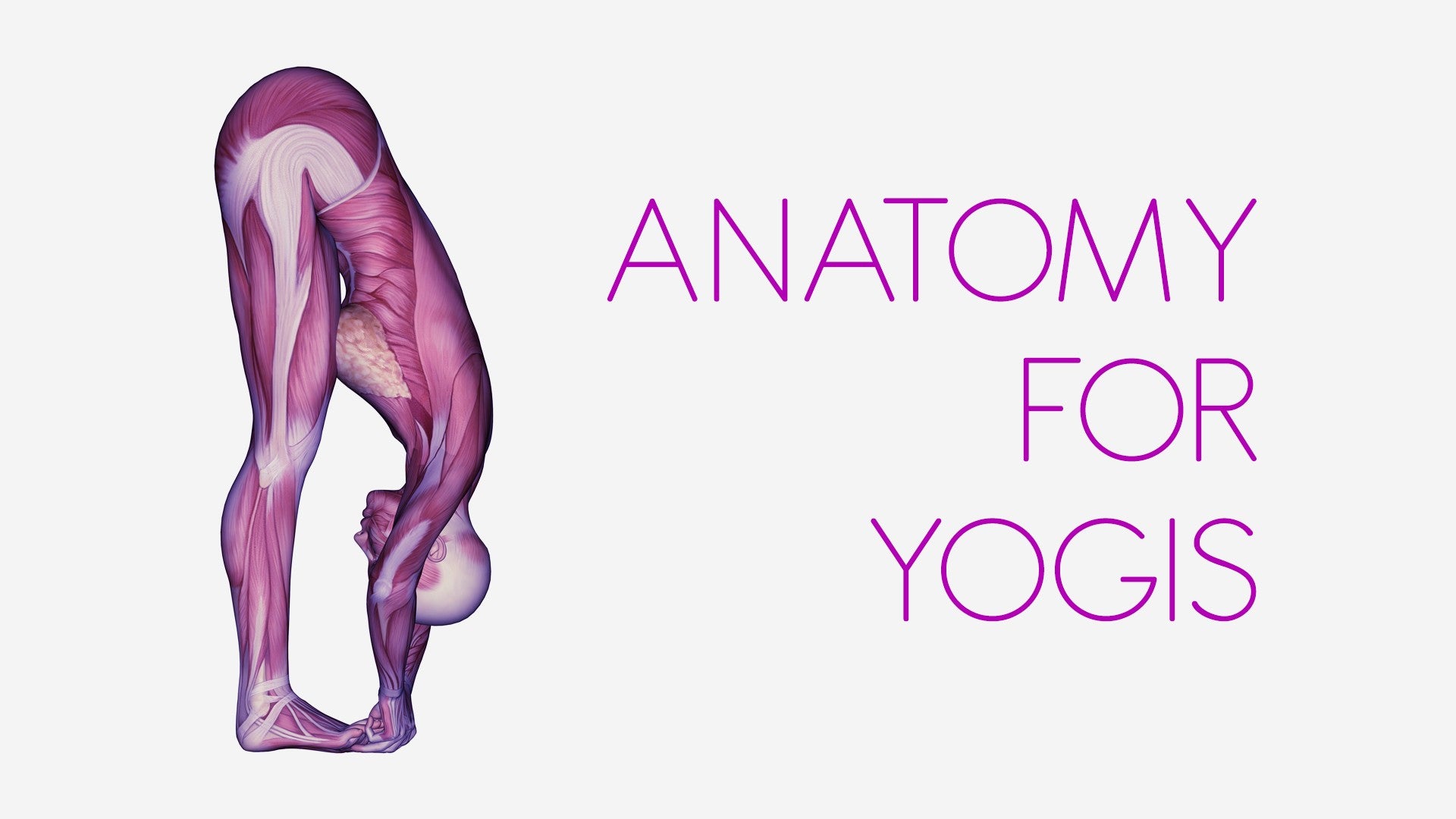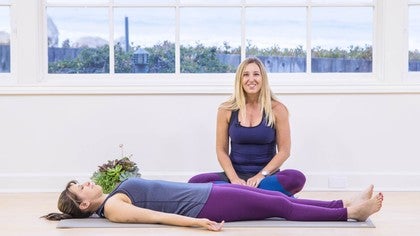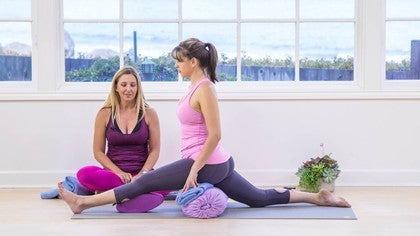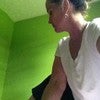Description
About This Video
Transcript
Read Full Transcript
Hi there, welcome back. I'm here today with Chelsea, my friend and assistant. She's going to be helping us out. This class is really about the feet and the ankles and also the knees. I kind of put it all together since they're all connected. But Chelsea is a great example today because we have quite different ranges of motion in our ankles and so at home you'll be able to relate either to the range of motion that I have or the range of motion that Chelsea has. But either way the work that we're going to do is good for anybody regardless of your range of motion. So for today's class what you will need is a chair, a block, and a strap. If you don't have a yoga chair at home any chair will do. Your dining room table chair will work just fine so don't feel like you need any special equipment for this class. And we'll get go ahead and get started. How does that sound? So go ahead and stretch your legs out in front of you. If you need to sit on a blanket feel free or a bolster or whatever you prefer, something comfy. And then go ahead and hold on behind your right thigh and just pull your right leg in. And then go ahead and lift underneath the shin bone. This is the best way to get your knee in toward your chest so that it protects the medial aspect of your knee. And then from this position take your left hand and go ahead and weave your fingers through all of your toes. If you're used to doing this you're you're gonna be very happy. If you're not used to this you're not going to be very happy. It is a little bit intense when you first do this but when you're done you'll realize that it's all worth it. So what I'm doing here is I'm getting my fingers as far in to the webbing as possible. You okay there Chelsea? And then just to be nice, play nice, just do a few little ankle rolls. It doesn't have to be intense. And then change directions. And then I like to do something called invert and evert. So you're going to invert your foot by turning the sole of your foot up. You're using your hand in between the toes to sort of twist your foot. And then you're going to invert, go in the opposite direction. Try to twist the sole of your foot down toward the floor. And just repeat that back and forth a few times. And then just come back to the middle, get your fingers in there again because they're probably sliding out a little bit. And then just hold on to the ball of your foot. You're holding on to the metatarsals here. And just you can use your opposite hand, your right hand, to sort of brace your shin bone down. And you're just going to stretch the sole of the foot so you're getting some length. And this is where your toes are starting to say, what are you doing? Because you're squeezing them. And now you get to squeeze them and get even harder. So relax. And then squeeze. And then relax again. And then one more time, you're not stretching your foot anymore. Just go ahead and squeeze, making a fist. And relax. And now here's the tricky part, is you will remove your toes from your fingers rather than your fingers from your toes. So your fingers don't do anything. And you have to figure out how to move those toes to free them. And then go ahead and stretch that leg out when you're there. Take your time. And just feel the difference between your feet. At home I invite you to get up and walk around. Just feel the difference. You'll notice the difference if you stand up immediately. You'll notice difference not only in your ankles but in your knees as well. And some of you might even feel a difference in your hips. And then you can join us for the other side. So go ahead and hold on at the bottom of your left thigh above the knee. Bring the knee in.
Take your hands underneath the lower leg and bring the knee in. We'll revisit this more at the end of class and talk about why this is a good way to bring your leg in. And then go ahead and take your right hand and interlace your fingers in between the toes. And we'll go through the whole thing on this side. Oh this side's different for me. Is it for you? Oh okay. Then just let's play nice for a little bit and just do a few little ankle rolls. Go one direction and then the other. And then you'll invert and evert. So invert is turning the sole of your foot up toward you, toward your face. You're feeling like the foot is getting a sort of figure eight twist in it. And then you'll you'll evert going the other way. So now you're twisting your foot down. And again up. Just repeat inverting and everting a few times. And then come back to the center. And now you'll have to get your fingers in just a little bit deeper. Hold on tight. You're holding on to the metatarsal heads. And you're going to stretch the foot. So you're getting some length. One of my toes is not really happy with this. The rest are okay. One's like help. And then relax. You're not stretching your foot anymore. Now just squeeze. So you're just trying to bring your fingers together. And then relax. And then one more time. Squeeze. And relax. And then just go ahead and slowly remove your toes from your fingers. Resist the urge to move your fingers. And then go ahead and stretch your leg out. And again if you want to get up and walk around, I invite you to do so. Feel the difference in the feet, ankles, knees, maybe even hips, and even the sacrum on the side. And then you can join us again. We'll do one more little foot exercise before we get into some of the bigger asanas. You'll just sit in baddha konasana. So you can hold on to your ankles. You can sit on a blanket as well. And what I'd like for you to do here is to really explore the maximum flexion and extension of your feet and your toes. So what you're going to do is you're going to pull the balls of your feet away from each other and curl your toes in. So you're making sort of an oval. I'm just going to point out you're making an oval shape in between the feet. Your feet might be cramping. That's okay. It means you need to do more of this. And then you'll go the opposite. You'll press the balls of the feet together and spread the toes apart. Your heels stay touching the whole time. And just go between the two. Notice that you're flexing and curling as much as you can, strengthening those arches. And then you're going to extend and spread and stretch. And then just do one more. Hold and then extend. Great. Go ahead and stretch your left leg out and bring your right leg in. So you're sitting on your pelvis. If you need to sit on a blanket underneath your right side of your pelvis, please do so. Now you're just holding on to your knee for support. Just begin to make some circles with the ankles. You'll go both directions again. There's no real technique here. I'm just exploring the full range of motion. So circles in both directions. But really try to push the range. Notice how there's one position where you tend to just rush right through it because you don't like it. So stay in those positions a little longer. And you can also point and flex what we call dorsi and plantar flexion. And here you can even invert and evert. So you turn the sole of the foot toward the midline, turn the sole of the foot away from the midline. And just go ahead and explore all of that. And now it gets a little more challenging. Press through the foot that's on the ground and lift the leg up and do the same thing. So now your leg muscles and your hip muscles are working a lot harder. And you'll might even notice that you get a stretch in the back of the leg. You'll notice that the quadriceps need to be nice and strong here to hover and hold the leg. Invert-evert. Point flex. Go through the full range. And then we're just gonna add one little thing because we want to target the knees a little bit. I'm gonna have you bend your knee in just a little bit. Good. And then reach through the heel and start to straighten the leg by reaching the heel out. Again bend your knee in. Feel that in the quads? I do. Do you? Reach your heel all the way out. So you're not just jamming the knees straight but you're rather trying to lengthen the leg. One more. Bend in a little and stretch out through the heel and then slowly lower the leg down. Okay so let's go ahead and switch sides. Bring your left leg up. Hold on around the leg just to support yourself. Again you can be sitting on a blanket and then just go through the range of motion. So it's circles, dorsiflex and planar flex and invert and evert. And I'm just gonna let you sort of play with that on your own. And the idea is that you spend a little bit more time in the ranges that you don't enjoy. Or the ranges that are unfamiliar to you. Or the ones that cause a little bit of cramping. I know that sounds kind of mean and I'm not mean I swear. But the cramping is a sign that you're pushing a range of motion that you're not familiar with. And so I usually say you know that it's a good thing. Don't run away from it. If you can be with it for a moment you'll you'll make more progress than if you just shy away from it. So whatever that range is for you. And then after you've explored those now we get to work the leg a little bit. So go ahead and lift up. Nice. And then again you'll do some circles.
And I'm doing this with you just so you know I sympathize. Because it's not easy. Change directions. And then let's planar flex point and dorsiflex and just go back and forth. And my guess is that your quads or your hip flexors are starting to get a little angry here. It's okay they just need to be strengthened. And then let's invert and evert. Yeah there goes my right quad cramping. And then go ahead and bend your knee in just a little bit. You can see if you're looking really closely we're trembling up here. Reach through the heel to lengthen the leg and have that be what straightens the knee. And then again bend in and straighten. A lot of us just tend to jam the knee right and there's no integrity in the muscles and the ligaments around the knee. So one more bend. Try to lengthen the leg. You're just reaching and then slowly bring the leg down. Nice. Then go ahead and just sort of shake the legs out. Bring some blood flow into the muscles. Okay so we're going to do a little bit of ankle work. PNF style which is one of my favorite ways of doing stretch work. So go ahead and start with one foot in front of you. Let's all do the right foot so we're the same. And you'll just sit on your left heel with your right foot on the floor in sort of this kind of funny squat position. And what you'll do is you'll push your knee forward into your full range. Don't let your heel lift. So I'm not going to do this. I'm just going to talk you through it. But if you go too far your heel will lift. So Chelsea's going to go too far just so you can see at home. Right? You want to make sure your heel stays down. So go ahead and put your heel down. So now that you're at your end range here comes the challenging part. I want you to try to lift your whole foot to bring it up toward your shin. So it's not going to go anywhere most likely but you'll be engaging all the muscles here across the front of the ankle. So it's not just your toes. You're trying to lift your foot as hard as you can. Good. Just a few more. A few more seconds. And then go ahead and relax. And now push your knee further forward. You're going to notice you have a little bit of an increased range of motion. And then do it again. Start to lift your foot. Lift your foot as hard as you can. So you're going to feel some burning here across the tib anterior. Maybe even across the top of the foot. That's those muscles working. And then relax. And then push forward a little bit more. Nice. And then go ahead and relax. Before we do the other side, this is a great opportunity to test. So Chelsea, I'm just going to have you come into a squat. Molassana squat. And just bring both feet down in a squat whether your heels touch or not. So in the beginning of class I mentioned that we look a little different because my heels do come down and Chelsea's don't. But that doesn't mean I don't do this work. We can, there's always more range available. So you can feel the difference between your right and left, right? I'm sure at home you can too. So let's do the left side. You're gonna sit on your right foot. Left foot comes in front of you and then you just push forward. Knee comes as far as you can without lifting the heel. And then the work is to contract the muscles across the front of the foot and the shin. So you're just trying to lift the foot. I would say like if you're, you know, you're driving sometimes you want to take your foot off the gas pedal really quick. That's what you're doing. You're trying to lift off the gas pedal.
And that, you know, 10 seconds usually is how long you hold this. And then relax and then push forward. You got about 10 degrees, 15 degrees, more range of motion possibly. And then again repeat. Great. And you should be going like 80 percent effort. Like maybe 90, even a hundred. You should be working as hard as you can here. And then relax and then push forward just a little bit more. This side's a little more stubborn for you. So what side is more stubborn for you, right? That's the side you might want to start with. Do the other side and then come back when you do this just as part of your daily practice. Okay, so let's come to child's pose. Okay, now we're going to explore a little bit of a different child's pose because now we just stretched out the front of the feet. Let's go back to the soles of the feet. So come up a little bit onto your knees and then go ahead and lift your pelvis up off your heels. So you're almost on all fours. And then tuck your toes underneath you and try to get all the toes down, even the little toe. And when you try to get the little toe down, don't let the big toe come off. So try to get all ten toes down. Good, so a little bit more on your big toe side. And then from here push back into child's pose. So you're just stretching the soles of your feet. And then from here go ahead and come up into a downward dog. And just wiggle around, move around a bit. This is the first sort of strength, whole body pose that we've done. So it doesn't have to be super intense. Just allow yourself to settle. And then go ahead and look at your ankles. We just did a lot of ankle work. And you know normally you'll hear things like press your heels down. I'm less concerned about you pressing your heels down and more interested in what your ankle can do. So go ahead and lift your heels here and then lower them back down. Try not to compress the ankle rather than just trying to do that sort of PNF work that we did before where you're trying to bring the foot toward the shin bone instead of just pushing the heels down. And do that three or four more times. Just lift the heels and start to lower down. And then we'll just add a little warm-up flow to this. So the next time your heels come down go ahead and come forward into a plank. And then even point and flex the feet here a little bit. So you will shift forward a little on your shoulders. Please take care of your wrists. If you need to do a longer plank I'm fine with that. But just feel how the feet can move the whole body forward and back. Do one more. And then go ahead and pull back into a downward dog. Nice. And then go ahead and step your right foot forward into a lunge. Just come up onto your fingertips. And even here in this lunge position, what would happen if you tried to lift the front foot off the floor? If you tried to come up off the gas pedal, what does that do to the rest of your leg? How do you feel in the lower leg, in the hip, around the knee? And then go ahead and step back into downward dog. And then go ahead and step your left foot forward into a lunge. Come up onto your fingertips. And do the same work with the left foot. Try to lift the foot off the floor. Nice. And then step back into downward dog. Come forward into plank. So take a little mind work here, a little coordination. Please lift your right foot up, the right leg up, so you're in single plank, a kapata plank. And now can you point both feet and flex both feet? So your one foot's on the floor, one foot's in the air, and then you go back and forth, point and flex. Excellent. So one, you have a closed chain, the other have you an open chain. So your mind has to think a little bit here. Do one more and then put that right foot down. And then you can either go to down dog and rest, or you can switch sides. We'll rest.
And come forward to plank again and do the left side. So you'll point and flex. So both feet are moving, not just the one that's in the air. Do three total. Nice and slow and nice and controlled and deliberate. And then go to downward dog. And then go ahead and come down into child's pose. Just the classic child's pose. Stretch the front of the feet, give them a little bit of a break, and rest for a moment. So go ahead and now get your chair and we'll move on to some chair work. Now that you've gotten your chair, go ahead and just make your way to standing. You can come through downward dog and walk forward, you can just stand up. I'm not really that picky. And once you're all the way to standing, we're gonna practice Uttanasana with your hands on the chair. The reason I have your hands on the chair, even if you can touch the floor, but I have your hands on the chair so we can really focus on some work in the legs and the knees. It's not about maximum stretch. So go ahead and come forward from hip hinge, hands on the chair, Uttanasana. Your arms will be straight, so it's gonna look more like Arda Uttanasana or maybe even less than that. And arms are straight, spine is straight, and you're standing with your pelvis right over your heels. And then what you'll do here is you'll bend your knees a little bit. Nice and just straighten your knees the way you do. Just straighten them. And for most people, I find that we just tend to jam our knees back behind us because it's just a very easy, effortless way to straighten the knees. What I'd like to do, and I kind of touched on it when we were seated, was to bring a lot of muscle work in the legs, which will help strengthen the knees as well. So go ahead and bend your knees again. And then this time, think of where your pant seam is. There's not one here, but imagine you have a pant seam, and that there's a zipper, and that you're sort of pulling up, you're sort of zipping up along the pant seams, and let that be what straightens the knees. So now suddenly, go ahead and repeat just over and over, bend and straighten. So again, it's that sense of lengthening. It's like you're trying to lengthen the knee open rather than just pushing it back. And you might be trembling, and that's okay. And as you get better at this, you can start to bring your hands lower. You can put your hands on blocks or even on the floor, but it's a real challenge with the hands on the floor. Do one more. Great. We'll come back to that. So now just go ahead and come into a low squat, malasana squat. Heels or feet are hip-distance apart and straight. I know sometimes we teach to take the heel or turn the toes out. What that does when you turn the toes out is it doesn't let you dorsiflex the ankle. So you end up pronating in the foot. It's a great work around, but it's never going to improve your dorsiflexion. And I'm interested in making you work to improve your range of motion. So if your heels lift, then you'll use the chair. If your heels reach the ground like mine do, you don't need to use a chair. It'll be a little bit harder, and I'll demo that in a moment. But what we're basically doing here is calf raises. So Chelsea's going to lower her heels as much as she can, and then she's going to lift the heels as much as you can. So the calves are going to get a good solid workout here. So you just lift and lower. The key is that you don't just collapse to the floor and push hard to lift up, but that you go very, very controlled and very, very slow through the full range. Just like before, if you find an area that you want to rush through, you should stick there for a little bit and work at it. So if your heels do come all the way down, you can just interlace your fingers out in front of you. And now you're working with balance. My arms are strong and stable, and you can start to lift all the way up. I'm just going to look at my hands so I stay focused. And then with control, you'll lower down. And my calves are working hard. And right about here, I'd like to just give up. So the idea is that you'll just stick in that area and hang out for a little bit, be with the discomfort, and really explore your motor control through the full range. Whoops, there I go. Just do about two more because your legs are probably dying. And then go ahead and stand all the way up, Uttanasana. You can use your hands on the chair or just forward fold at the top of your mat. Whatever is good for you. So go ahead and step your feet wider than the mat now. Keep your hands on the chair or on blocks. And what you'll do is you'll bend one knee, keeping the other one straight, shifting your hips to the side of the bent knee. And then you're going to switch to the other side, back and forth. And this moves the hips a little bit, but I'd like you to focus on the knees because this class is about ankles and knees and feet. And as you start to straighten the leg, you'll imagine that that outer thigh is zipping up just like we did before. So as you come over to the side, the outer thigh is pulling up and that's the contributing factor of straightening the knee rather than just pushing it back.
And the one little thing I'm going to add is the opposite action because it's yoga and there's always an opposite action. And that's that the inner thigh reaches down toward the knee. So as you straighten the leg, the inner thigh reaches to the inner knee and the outer knee reaches up to the outer hip. And you should feel a lot of work in the legs. Happy knees. Good. Finish this one. Make sure you end on the second side so you're even on both sides. And then come back to the center and walk your feet together. Uttanasana. Hands on the chair. Nice. And then slowly walk up to the chair and go ahead and stand all the way up. Nice. Good work, Chelsea. Okay, so go ahead and move the chair aside because you're going to need the full length of your mat to do warrior two. Okay, so go ahead and step to face the long edge of your mat. And it would be a good time to grab your block if you didn't grab it before. I'm going to go ahead and place it on the right back corner of your mat. You might need it because we'll do go to half moon from warrior two. So from here go ahead and step your feet wide. Hands can be on your hips. Make sure they're wide enough. The biggest thing I see is that people don't step wide enough in the standing poses. There's not enough work if you don't stand wide. And then go ahead and take your arms straight out to the side. Go ahead and turn your right leg out all the way out, turning from the hips so the toes face the shortage of the mat. Turn your left foot in just a little bit and go ahead and bend the knee. Once your knee is over the ankle, now's the when we start the work. So can you take that inner right thigh and stretch it long, stretch it all the way out from the inner right thigh all the way out to the knee? And then can you change that direction, go from the outer knee and pull it all the way up to the outer hip like along the seam of the pants? And you should feel a tremendous amount of work here so that the knee sort of finds its position through strength in the leg and the leg muscles and the hip muscles rather than just sort of a random position that we tell you. And can you keep that feeling? Inner thigh out, outer thigh in. As you lift the heel up, the right heel will lift and then slowly lower it, don't just collapse it down. Do three of those, I know it's a lot of work. Really feel how the whole leg contributes to this work and where in what position you tend to want to give up. That's where you got to stay just a few seconds longer. One more, nice. Good and then straighten the leg just a little bit and go ahead and set yourself up for half moon. You can just move into half moon right from here. I know it's a lot on the leg. It's good for endurance. Use the block. Once you're in half moon and you find yourself balanced, please go ahead and look at the floor because we're gonna do some extra work here. It's gonna be some moving work. You'll bend your right knee, the standing leg and you'll do the same work. As you straighten the knee, can you stretch the inner thigh down and the outer thigh up? So you're doing these opposite actions and you should be trembling. I know Chelsea is. Do three of those, just three. Go as slow as you can and be as deliberate as you can. Last one. Again, you're not jamming the knee back and then when you're ready, soften the knee, reach that left foot way back, come all the way up.
Good and then straighten the leg and turn the feet in. You can rest your arms. Good. Go ahead and grab your block and put it on the other side. Take your arms out unless they're super fatigued. Then you can keep them on your hips. Turn your left leg all the way out. Turn your right foot in and bend your knee. So if you're new to this and you're struggling a little bit, you can sort of trick your mind by actually extending your body out beyond its borders. So sometimes I like to envision that the line that I'm drawing from the inner thigh to the inner knee actually goes way out beyond the body and all the way into the horizon. And then all the way from out in the horizon, it comes all the way back in, turns around, trembling, and it pulls the outer knee all the way up to the outer hip. So that's the work here. Rather than just sort of moving the knee side to side, your knee will find its position based on what your leg muscles can do. And then go ahead and lift the heel and lower down. Do three of those. Don't unbend the knee. Keep the loop in the thigh and really notice at what position you want to give up. After your third one, you'll get yourself ready for half moon. Take the block with you. You can straighten the leg a little bit. I know that leg is so tired. It's not easy. And then go ahead and bend your knee and straighten. Again, inner thigh is reaching down to the inner knee, outer knee is reaching up to the outer hip. Just do three of those. So the work here is for those of you that you understand the shapes, you understand the poses, you know what to do in half moon, but there's always more. So this is my way of never checking the poses off the list is to add a little bit more strength and endurance to them. After your third, go ahead and step all the way back. Good. And then go ahead and straighten both legs. Turn both feet in and forward bend. Just relax and then gently start to straighten the arms. Stretch your chest forward a bit. Bring your hands onto your hips and slowly hinge up all the way to standing and step your feet together. Nice work. So we're just going to wrap up the class with a few poses on the floor. So go ahead and make your way to seated.
Alright, so go ahead and sit on your mat completely stretching your legs out. Come over here. If you need to sit on a blanket, feel free. Now's a good time to grab your strap. So I said I'd mention this earlier in class. I said I'd talk a little bit more about how to bring your leg in to best protect your knee. So Chelsea, can you show us how we normally see our students bring our knee in or leg in for Janu Shisasana? Exactly. So we usually pull over the top and we pull over the top. We tend to compress the medial aspect of the knee. Also, as you might have noticed, go ahead and stretch your leg out. We're not always pulling from the thigh bone because the hip needs to move here too. So Chelsea, go ahead and move back just a little bit so we can see everything. Great. Perfect. Okay, and will you demonstrate how we like to see or how we see our students like to pull the knee in? So if you saw that, Chelsea kind of pulled over the top and just gave the shin a yank. We don't want to do that. We want to really teach the hip to move and leave space in the knee joint. So go ahead and stretch your leg out again. So to pull your leg in for Janu Shisasana, the best way is to hold on behind the thigh, so above the knee, just like Chelsea's doing, and to pull the leg in, and then to hold on underneath the shin, which creates space in the medial aspect of the knee rather than compressing it and finding a comfortable position. You might want to grab your strap and go ahead and loop the strap around the outstretched leg, which in this case is your right leg. And the work here is not for you to just go into a deep forward bend. It's to put all of this work together. Your left knee should be very happy. I'm going to have you go ahead and gently bend the right knee just a little bit, and then just like we've been doing, instead of just pushing the knee down to straighten, can you reach? So you're pushing into the belt and pulling the thigh muscles all the way up and in, being not technical on purpose. Good. And then you can maybe inch the hands down the strap just a little bit, but keep the work in the leg. And what you might find is that when you activate the muscles in the legs, you'll actually get more of a stretch sensation. When you're doing sort of isometric work at these end ranges, it feels good. It feels like work. I think sometimes we get lost in the chase for the sensation and we seek it in ranges that we don't have a lot of control in. So it could be very beneficial for you sort of to ease up a little bit and then contract the muscles in the legs while you're stretching them. And then we'll switch sides. Go ahead and slide your hands up the strap, stretch your left leg all the way out, and then right leg. So behind the thigh, above the knee, you pull the leg out, and then you hold on underneath the shin. Great. This really encourages the rotation in the hip that you need. And then take your strap. Again, don't go to your end range. Just sort of go sort of mid-range. Back is nice and straight. You'll bend your knee just a little, and then when you start to straighten, you'll push into the strap with the lower leg and pull all the way up from the outer knee to the outer hip. Feel free to add the inner hip to the inner knee if you'd like. And then from here, you're contracting all the muscles in the leg, particularly those that you're stretching, hamstrings, calves. And you might go just a little bit further. Be very active in the pose. If you find that contracting the hamstring is a challenge in the stretched position, then I recommend you come out of the pose, contract there so you're less range, less stretch, contract there until you develop strength and motor control there, and then you can start to go deeper. And then slowly make your way up. You're done with the strap. You can set that aside. And then go ahead and end with bridge on a block before Shavasana. So grab your block. Chelsea, you're going to turn around. You can make your way to the ground any way you like. Knees are bent. Feet are about hip distance apart. And then go ahead and lift your pelvis up and slide the block underneath on just the lowest, just the lowest level. This is just a nice restorative posture to sort of settle the body, settle the mind. Shoulders are heavy. It's a slight inversion. And you've done a lot of work in the lower extremity. And so the proprioceptive input from the block should be really soothing for the lower back and the back of the pelvis sacrum area. You're welcome to close your eyes. Just notice the sensation in your legs. If you feel that holding your legs up is difficult because you've worked your legs really hard, you can always just loop a belt around your legs. It's actually a little bit comfortable so you can let the legs flop open to the side. The idea is that you rest here. Just take about five more breaths. Nice, long, slow breaths. Feel your shoulders get heavy in the mat.
And feel your pelvis sink onto the block. And as you finish up your fifth breath, when you're ready, you'll slowly push into the feet, lift the pelvis just a bit, slide the block out from underneath you. Then go ahead and lower the pelvis down slow. And then just feel the difference. Notice what the block did for you. Feel the void that's created by you removing the block. And then go ahead and stretch one leg out and then the other. And just notice how you lie. Notice your shavasana position. Is it the same position you always take? Does it feel different after you've spent thirty or so minutes working on the lower extremity? And if you are interested in sort of this exploration of what it is to just lie on the floor, you're always welcome to go and take the body scan class, which is a five, ten minute tutorial on sort of how to scan the body so that you can see how you rest, what your resting position is, what your patterns are. Always knowing there's nothing to fix or change. Just teaching you to better inhabit your own body. And if you choose instead, you can just stay here and spend, I would say for a thirty minute class, maybe seven minutes in shavasana. That would be my recommendation or whatever you have time for. And when you're ready to come up, you'll gently awaken the body by making small familiar movements, deepening the breath, stretching your arms overhead, and really reaching. I love to stretch and tense everything at the same time, just like your cats do. It's like the whole body is yawning. And then rest, and then bend your knees up, roll over to your side, and dipping your chest toward the floor, slowly roll up to seated, bringing your head up last. Find a comfortable cross-legged position, join your hands together at your chest, gently close your eyes, and bow your head down. Just observing how you sit, and then go ahead and gently lift your chin and open your eyes nice and slow, releasing your hands down to your thigh. Thanks for joining us. Thanks, Chelsea. We'll see you tomorrow. Namaste.
Anatomy for Yogis: Jules Mitchell
Comments
You need to be a subscriber to post a comment.
Please Log In or Create an Account to start your free trial.
















